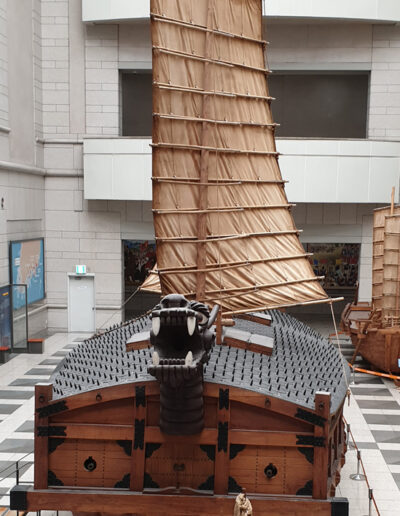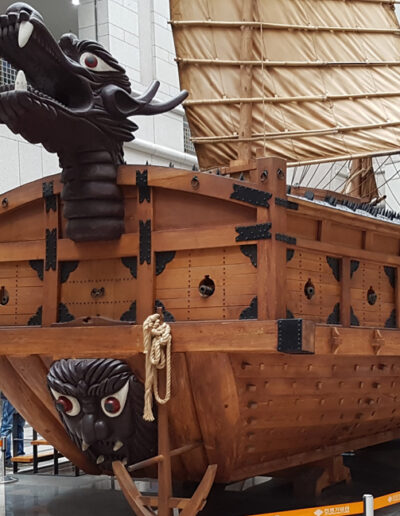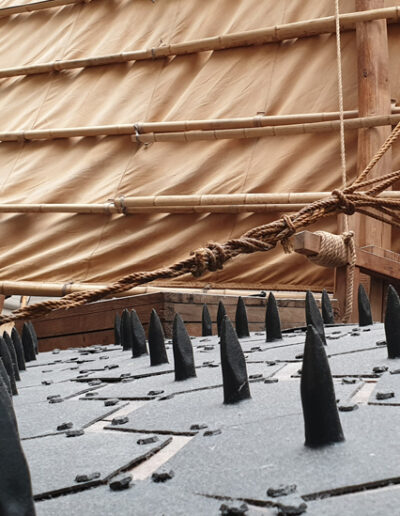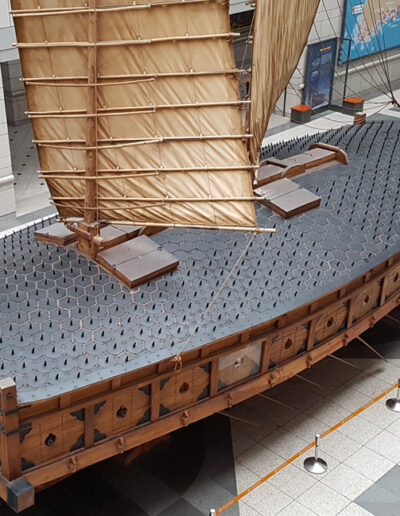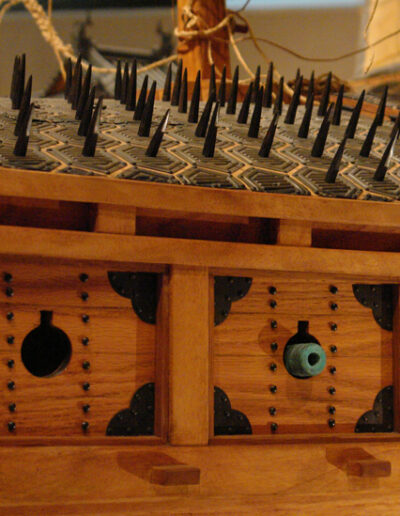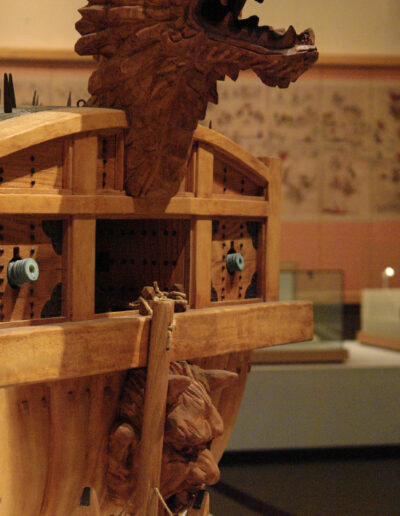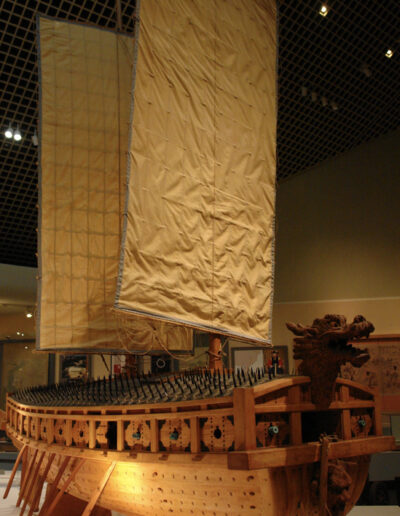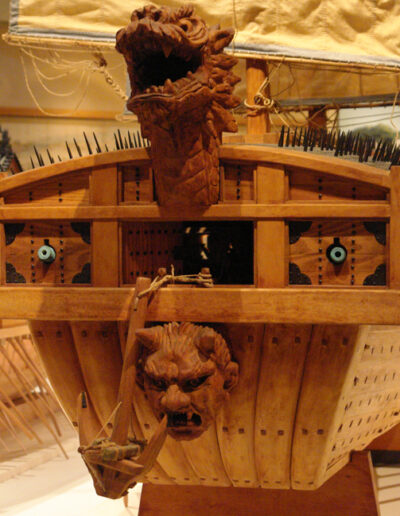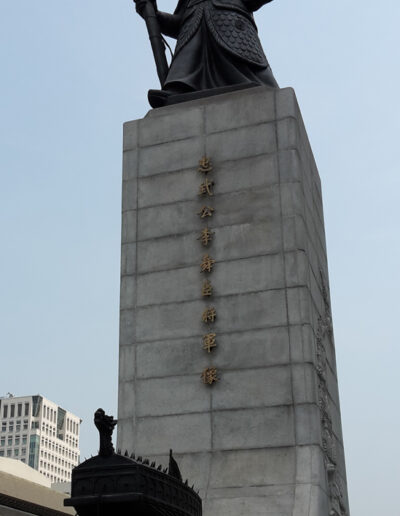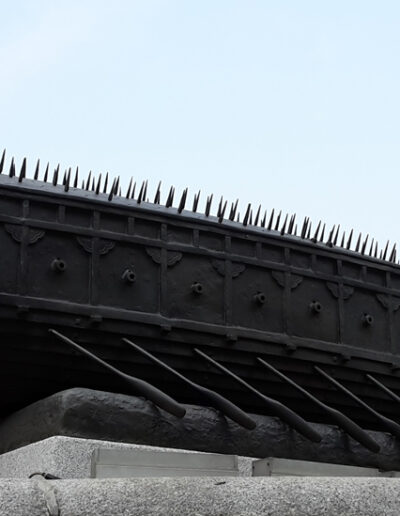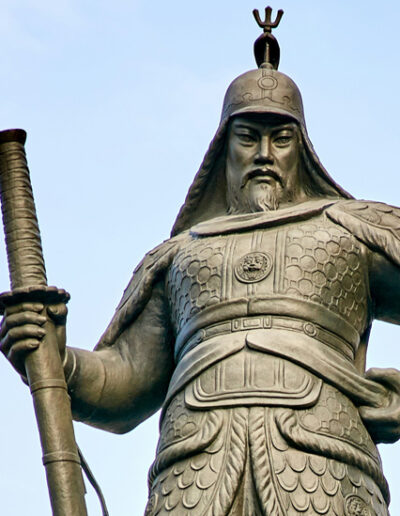The Turtle Ship and Admiral Yi Sun Sin
1590s
About the Object
Story of the Object
Teaching suggestions
Classroom Extras
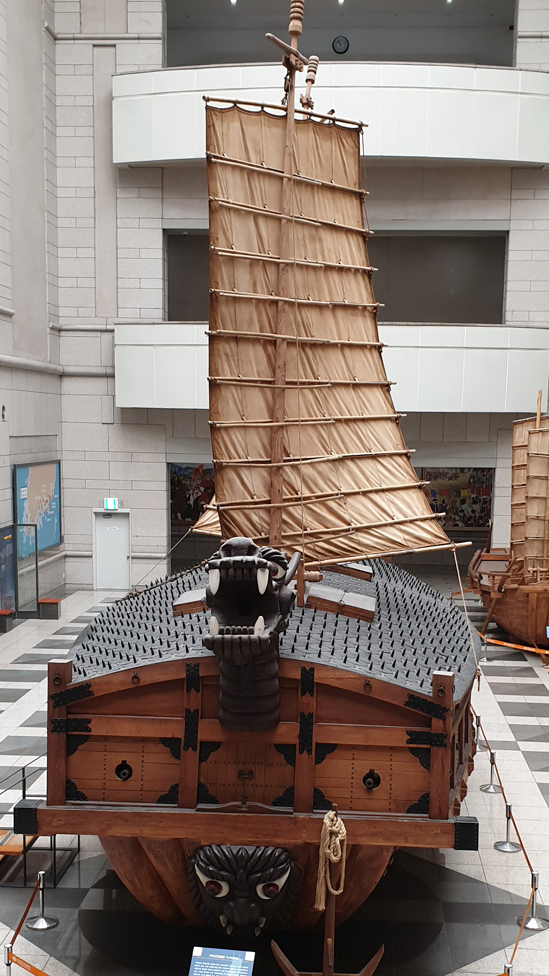
The Turtle Ship and Admiral Yi Sun Sin
The turtle ship, or Geobukseon in Korean, was a type of warship used by the navy of Korea from the 15th to the 19th Centuries.
It is first mentioned in the 14th and 15th Centuries, but it was refined at a time when Korea was threatened by attacks from Japanese warships in the late 16th Century.
The ship was so called because it was said to look like the shell of turtle.
Over the top of the main body was a cover through which were placed iron spikes facing upwards and there was a figurehead at the bow which resembled a dragon’s head.
It was developed into a highly effective warship by Admiral Yi Sun Sin, who became a hero in Korea for helping the country to defeat the Japanese invaders.
The turtle ship has been described by some historians as a very early type of ironclad warship and as a forerunner of modern warships.
A scaled replica of the turtle ship can be seen in the National Museum of Korea in Seoul, and another can be seen in the Saga Prefectural Nagoya Castle Museum in Karatsu, Japan. A full-size turtle ship is anchored at Yeosu.
Background: Conflict with Japan
Towards the end of the 16th Century, the civil wars which had plagued Japan for decades came to an end.
Toyotomi Hideyoshi, a Japanese samurai, a member of the ruling military nobility, and daimyo (a feudal lord) emerged victorious.
Having unified his country, he looked to build on this success and show his military and naval power.
He turned his attention to conquering China, ruled at that time by the Ming dynasty, and Korea, which was ruled by the Joseon dynasty.
It is clear that Hideyoshi had planned for a possible war with both China and Korea long before he completed the unification of Japan.
It is believed, that he ordered the construction of as many as 2,000 ships as early as 1586.
He planned to invade Korea first and use the Korean peninsula to invade China.
As a first stage, in 1587, he sent envoys to Korea to persuade the Joseon ruler, King Seonjo, (ruled 1567-1608) to join him in a war against China.
However, he was impatient and quickly followed that approach with an ultimatum that unless Korea submitted to Japan and participated in the conquest of China, Korea itself would be attacked and conquered by Japan.
Hideyoshi’s tactics did not work. The Koreans would not submit to him and, as a result, in 1592 he launched his armies against Korea.
Although the war lasted until 1598, it was divided into two phases from 1592-3 and from 1597-8.
Invasion: the first phase 1592-96 – Japanese success on land
The Japanese were initially highly successful and fought their way up the Korean peninsula.
The majority of the Japanese troops were ashigaru, which were foot soldiers and were usually conscripted peasants armed with spears, tanegashima, Japanese arquebuses, or yumi, Japanese bows.
Arquebuses were long guns, and the Japanese soldiers were trained to fight in the European style.
This meant that the guns were fired in formation to create a volley of fire.
The first row of men fired, then knelt to reload, while the men behind them fired.
The cycle was repeated over and over again.
The core of the fighting force were the samurai, highly experienced and semi-professional warrior soldiers who fought principally with swords.
Both the samurai and the ashigaru were protected by armour though that worn by the samurai was far superior to that worn by the ashigaru.
They also had artillery which was superior to the Japanese.
Korean soldiers used swords which were lighter than the Japanese ones and some carried a flail.
This was a wooden pole about 1.5 metres long which was painted red.
Attached at one end was a chain with iron nails and the flail was swung in the hope of disrupting any enemy formation and killing as many soldiers as possible who could be caught as the flail was swept from side to side.
The Koreans also used the hwacha.
This was a two wheeled wooden cart on which was mounted a rocket launcher which was capable of firing up to 200 arrows at a time.
War at sea: Korean success – the contribution of Yi Sun Sin
At the moment that Korea faced defeat on land and occupation by a foreign power, it found its saviour in Yi Sun Sin and his deployment of the Korean navy, especially the Geobukseon, or turtle ship.
Yi had joined the army as an officer in 1576 and over the next 15 years he showed his skill as a warrior and a leader.
In March 1591 he was appointed as commander of a naval district, and he took up his post at the port of Yeosu.
Here he focused upon strengthening the regional navy including the construction of the turtle ship.
After the Japanese attached Korea in 1592, Yi deployed his ships against the invaders and, although he had never led a fleet into battle before, he won several quick victories.
Hideyoshi needed command of the seas, so Yi’s’ victories made him realise the danger that Korea posed.
Although the Japanese hoped to overwhelm the Koreans by having superior numbers of ships, this tactic did not work.
Despite being outnumbered in battle, the Koreans were victorious in every single engagement with the Japanese at sea and won at least 15 battles in 1592. This resulted in thousands of Japanese naval casualties and hundreds of sunken Japanese warships and supply ships.
It appears that the Koreans lost very few ships.
Yi was successful for several reasons.
He had prepared well and ensured that there were sufficient supplies for his navy.
The Korean panokseon ships, wooden vessels powered by sail and oars, were also stronger than Japanese ships.
They were superior in construction, carried five times as many cannons as the Japanese boats (20 to 4), and the Korean cannons outgunned the Japanese ones in terms of power and range.
He also used a particular strategy by luring the enemy to chase his ships.
At a given signal his ships created a crescent or crane wing formation – the hakikjin strategy – which enabled his fleet to partially surround and destroy the enemy.
Yi was also a charismatic leader.
It is said that he respected his men, would fight alongside them and generally do what he could to maintain their morale.
He was also a capable strategist and used his knowledge of the Korean coast and tides to plan his attacks.
However, perhaps the principal reason for his success was that he used the turtle ship to great effect.
The Turtle Ship
Yi did not invent the turtle ship but improved older designs that had been suggested during the late Goryeo dynasty (lasted 918-1392) and the early Joseon dynasty, in particular the reigns of King Taejong (ruled 1400-1418) and King Sejong (ruled 1418-1450).
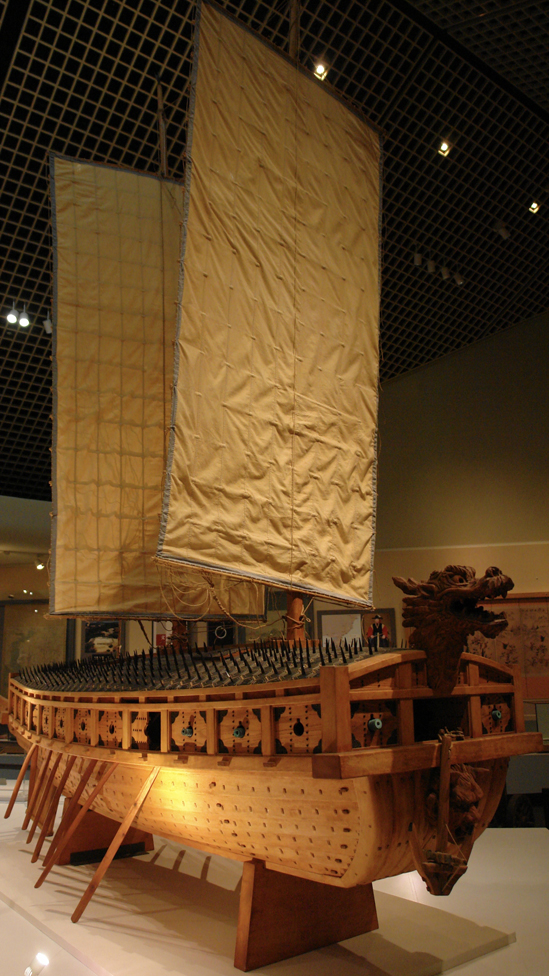
A scaled model of the turtle ship in The Saga Prefectural Nagoya Castle Museum in Karatsu, Japan © Dr Stephen Turnbull
In effect, Yi developed the design so that the boat could be used much more effectively and extensively in actual combat.
Korean and Japanese accounts of this period refer to turtle ships.
However, no ship has survived, and there is still debate about what turtle ships looked like and whether they had an iron plate placed over the boat to help protect the sailors.
There is, though, agreement that they were turtle-shaped and equipped with many cannons, eleven on each side and two each at the stern and the bow.
The ship’s figurehead was in the shape of a dragon and held up to four cannons.
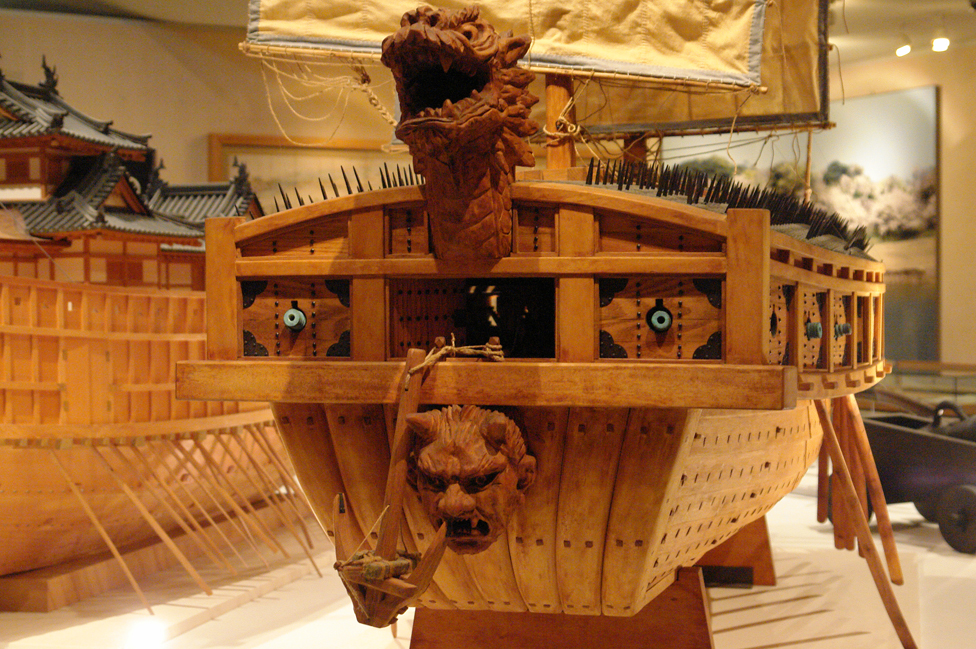
A scaled model of the turtle ship in The Saga Prefectural Nagoya Castle Museum in Karatsu, Japan © Dr Stephen Turnbull
During a battle, smoke was released though the mouth of the dragon which was intended, together with its fierce appearance, to frighten opponents.
The sides of the turtle ship had small holes through which arrows and guns could be fired.
The Korean strategy was to fire their guns and cannons at a range which would prevent the enemy coming close enough to board them.
If an enemy warship managed to come alongside, the roof of the turtle ship was covered with wooden planks on which were placed rows of spikes.
These spikes were there to prevent the ship from being boarded because Japanese ships were taller out of the water and so sailors wishing to board would have to jump down onto the roof and risk serious injury.
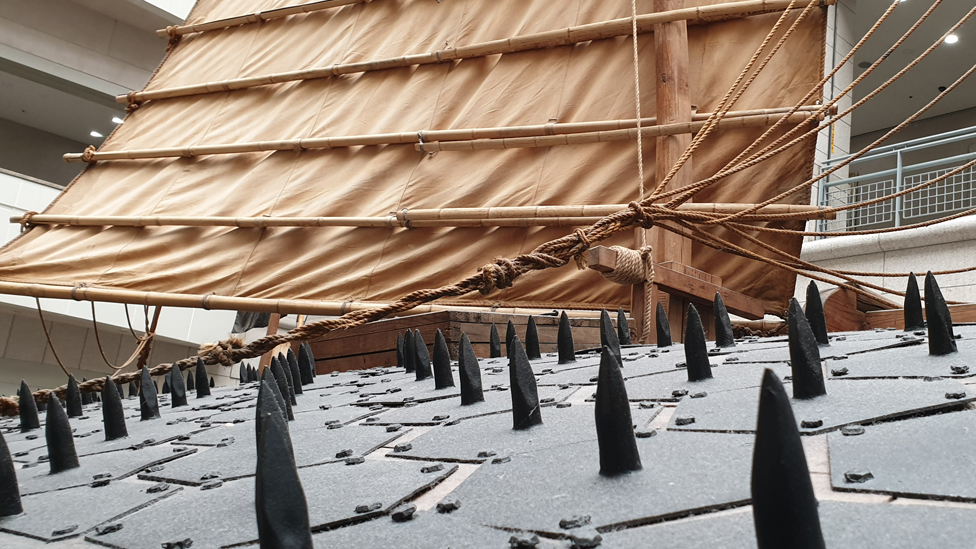
A replica of the Turtle Ship (scaled model 1:2.5) in the War Memorial of Korea Museum, Seoul
Each turtle ship had two large sails, one on each of the two masts, and was powered by 20 oars each pulled by two men during fine weather and five men in rough weather or battle.
The ship had multiple layers to separate the rowers from the cannons.
Turtle ships were mostly used to spearhead attacks and were best used in tight areas, for example, in straits and around islands, rather than the open sea.
The turtle ship was such a success because it had superior fire-power and structural design.
The iron spikes on the roof, cannons placed at every angle and the emission of smoke from the dragon’s head to frighten and provide cover all combined to help the turtle ship win in battle.
In addition, the ship was well-suited for ramming, as it was stronger than the Japanese ships due to the use of red pine timber and wooden nails which expanded as they absorbed seawater, thus making the ship as watertight as possible.
Invasion: the second phase, 1597-98
Following intervention from Ming China in 1593 to support Korea, the Japanese gradually retreated and by the end of the year most Japanese soldiers had withdrawn from the Korean peninsula.
The years 1594-96 saw a series of peace negotiations but they failed to produce a peace settlement.
Toyotomi Hideyoshi had not given up on his desire for overseas conquest and in 1597 war resumed with the Japanese again invading Korea, this time though with the intention of just conquering Korea.
The Koreans were better equipped and prepared, and Ming China provided immediate and much needed support.
It was clear that the navy under the command of Yi Sun Sin would again play a decisive role in defending Korea by firstly interrupting attempts by Japan to land men and resources and secondly disrupting any supply ships.
It was at this point that Yi was faced with a major decision.
As a result of information from a Japanese double spy – that is one who was pretending to spy for Korea but was actually working for Japan – Yi was ordered by the government to undertake a surprise operation against the Japanese navy.
Doubting the reliability of the information because it indicated that he would have to sail his fleet through dangerous shallow waters, Yi concluded that the Japanese were setting a trap for him and his ships.
As a result, he refused to obey the order.
His enemies at court who were jealous of his success persuaded King Seonjo to demote and jail him for disobeying orders.
A replacement – Won Gyun – was appointed as commander of the fleet.
However, without sufficient preparations and planning, the new commander launched the entire Korean navy – almost 100 ships – against the Japanese navy.
At the subsequent Battle of Chilcheollyang in August 1597, Won Gyun was completely overwhelmed by the Japanese and all but 13 of his ships were destroyed.
Won Gyun was also killed.
This battle was Japan’s only decisive naval victory of the war.
The Japanese could now land their troops on the Korean peninsula without disturbance.
Realising the seriousness of the situation, King Seonjo released Yi and reinstated him as head of the navy.
Yi set about reorganising and reequipping his ships and in October 1597 he again faced the Japanese navy at the battle of Myeongnyang.
Despite only having 13 ships, he routed a much superior force of 133 warships, destroying 30 ships and severely damaging a further 30, and without losing any of his own ships.
As a result of the difference in the size of the fleets, the battle of Myeongnyang is considered Yi Sun Sin’s greatest victory.
The war continued on land and at sea for another year.
With the death of Toyotomi Hideyoshi in September 1598, though, the Japanese decided to end the attempt to conquer Korea and in October they ordered all their forces to withdraw from the peninsula.
One further sea battle took place in December 1598 and turtle ships again played a key role in the Korean victory at the battle of Noryang.
However, during the fighting Admiral Yi Sun Sin was killed.
The significance of the Turtle Ship – was it the world’s first ironclad?
Following the battle of Saechon in July 1592, Admiral Yi related what had happened to King Saejon.
He wrote in his report: “Previously, foreseeing the Japanese invasion, I had a turtle ship made…with a dragon’s head, from whose mouth we could fire cannons, and with iron spikes on its back to pierce the enemy’s feet when they tried to board.
“Because it is in the shape of a turtle, our men can look out from inside, but the enemy cannot look in from outside. It moves so swiftly that it can plunge into the midst of even many hundreds of enemy vessels in any weather to attack them with cannonballs and fire throwers.”
Stephen Turnbull, 2002
The turtle ship helped to save Korea at this time from complete defeat and occupation by the Japanese.
Although turtle ships were the most important part of Admiral Yi’s’ fleet, he never used more than five in any one battle.
As a result, they were only ever in a minority within the ships of the Korean navy.
They were used in all 15 naval engagements between May 1592 and March 1593, in what was the first phase of the Japanese invasion of Korea.
They were not used widely in the second phase invasions in 1597-98 apart from the decisive Battle of Noryang in 1598.
The turtle ship continued to be part of the navy for the following three centuries but with changes in design and tactics they were gradually replaced by more sophisticated vessels.
Admiral Yi Sun Sin – a Korean hero and outstanding naval commander
As for Admiral Yi, he was victorious in all the 23 battles against the Japanese invaders, and this is an unprecedented achievement in world naval battle history.
In most of these battles, he was outnumbered and lacked necessary supplies, but he was able to outsmart his enemies even when the odds were stacked against him.
He is regarded as a great naval commander, and he is revered in Korean history for his heroic actions in rescuing his country from near ruin during the Hideyoshi Invasions.
We know so much about him and the war against Japan because his diary of the period 1592-1598 has survived.
It describes in detail the “daily combat situations, the admiral’s personal views and feelings, observations on the weather, topographical features of battlefields, and the lives of common people” and is regarded as “without equal in world history as a commander’s battlefield account”.
Nanjung Ilgi, The War Diaries of Admiral Yi Sun-Sin
The historian Stephen Turnbull regards Yi as “the greatest hero of the defeat of the Samurai invasion of Korea” and “one of the outstanding naval commanders in the entire history of the world”.
S Turnbull, The Samurai Invasion of Korea 1592-98, Osprey Publishing; 1st edition (2 July 2008), page 5
Yi is celebrated as a national hero, with numerous statues in his honour, as well as numerous films and documentaries focussed on his exploits.
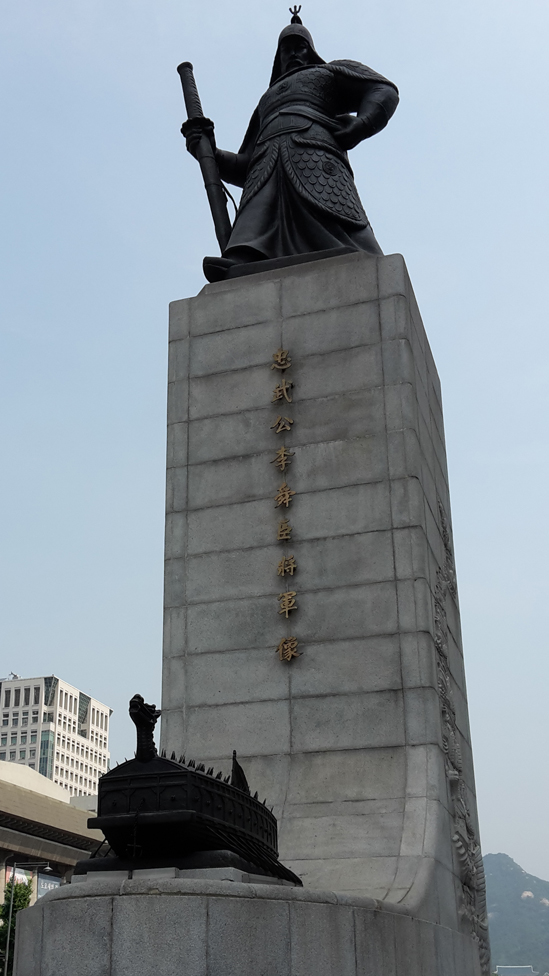
The statue of Admiral Yi Sun Sin, on Sejong-daero, Gwanghwamun Plaza, Seoul
Retrieval practice
1. Turtle ships were first mentioned in which centuries?
a) 14th and 15th centuries
b) 16th and 17th centuries
c) 18th and 19th centuries
2. What figurehead commonly appeared at the bow of a turtle ship?
a) A snake
2) A dragon
3) A horse
3. At which port city on South Korea’s East China Sea coast can a full-size turtle ship be seen?
a) Busan
b) Incheon
c) Yeosu
Timeline / Fact Files
The Japanese conflict with Korea lasted from 1592 to 1598. This was the great era of the turtle ships and Admiral Yi Sun Sin. Choose one of the following (or even instruct students to do both):
- Create a timeline of the conflict. You might want to ask students to begin in 1587, when Toyotomi Hideyoshi sent envoys to Korea to try and persuade King Seonjo to join him in a war against China. Make sure student focus on key dates and key events.
- Create a fact file for Admiral Yi Sun Sin. Don’t just focus on his military career but have categories about his early life and his legacy. Students might want to think carefully about how he is remembered today.
Famous ships and famous sea battles
For example, in 1588, King Philip II of Spain sent a large fleet of 130 ships to invade England. The Spanish Armada (as the fleet was known) arrived on the English coast, but the English outwitted them. Some ships sunk, and storms damaged some while they tried to go back home. The English and the Spanish has contrasting types of ships, and contrasting styles of warfare. This would make an interesting research topic.
There are many other sea battles to research. Examples that are easier to find information on include:
The Battle of Salamis in the Greco-Persian Wars (one of the first naval confrontations in recorded history); the Battle of Trafalgar in October 1805, when Admiral Nelson led the British Royal Navy against Napoleon’s forces; the Battle of Jutland (the one major clash between British and German fleets in World War One).
There are also many well-known ships that could form part of a research project. You might want to get students to research types of ships, that were revolutionary when created (for example, the Dreadnought class of battleships in World War One or Zumwalt Class Destroyers of the US Navy) OR ask them to research well known individual warships.
Examples that are easier to find information on include: HMS Victory, USS Constitution, German battleship Bismark, HMS Hood, USS Midway, Japanese battleship Yamato and HMS Argus.
Comparison
It’s a good idea to get your students to compare Korean turtle ships used by Yi Sun Sin with warships used in the west.
One problem we have here though is the fact that there isn’t a firm view on the exact design of turtle ships from the late 16th Century.
You could ask your pupils to read the information about turtle ships on the Story of the Object tab AND from this Wikipedia page.
Get your pupils to agree what they think the main features of a turtle ship were. Establish some clear criteria for comparison for example tonnes in weight, number of canons, numbers of crew, length etc. Then you could get your class to compare them to ships used in the Spanish Armada. You could use this Wikipedia page – List of ships of the Spanish Armada.
Where else in the world?
The Japanese conflict with Korea lasted from 1592-1598. It’s a good idea for pupils to find out what else was going on in the world at this time.
Ask pupils to research important who people lived at this time, or what other important events or developments took place? This could have a Korean focus, or, it could be expanded to give a global perspective.
You might want to widen the period of study to the 1580s.
For example in 1588 the English under Elizabeth saw off the Spanish Armada.
John White returned from Roanoke after an unsuccessful search for the last colonies and it is agreed that the hand-held revolver had been invented by the 1590s.
Write a plaque for the War Memorial
Ask your pupils to write a plaque for the replica in the War Memorial Museum in Seoul.
They could work individually, in pairs or in groups.
You could support them by giving them to following headings to find out about:
- How Yi Sun Sin used Turtle Ships in the war with Japan in the 1590s?
- What was the design of the ships?
- Why were these ships effective in battle?
- What is there significance in Korean history?
After they have completed their research explain to them that they need to write a plaque for the famous replica.
Give them a word limit of 40 to 50 words. This makes the task much more difficult as they will have to choose their words carefully.
Classroom Extras
Here you will find a number of images, video clips and website links which can be used as extras for teaching in the classroom or for use by pupils undertaking independent research.
Images
Study these images of the Turtle Ship and Admiral Yi Sun Sin:
A scaled model of the turtle ship in The Saga Prefectural Nagoya Castle Museum in Karatsu, Japan © Dr Stephen Turnbull
A scaled model of the turtle ship in The Saga Prefectural Nagoya Castle Museum in Karatsu, Japan © Dr Stephen Turnbull
A scaled model of the turtle ship in The Saga Prefectural Nagoya Castle Museum in Karatsu, Japan © Dr Stephen Turnbull
A scaled model of the turtle ship in The Saga Prefectural Nagoya Castle Museum in Karatsu, Japan © Dr Stephen Turnbull
Map
Select Google Maps options to view key locations for different objects:
Videos
Watch these videos about the turtle ship, the war with Japan and Admiral Yi Sun Sin:

Discover more online
Google Arts and Culture: The Turtle Ship
: Yi’s personal diaries, Nanjung Ilgi, covering the period 1592-98, are listed as part of UNESCO’s Memory of the World.

